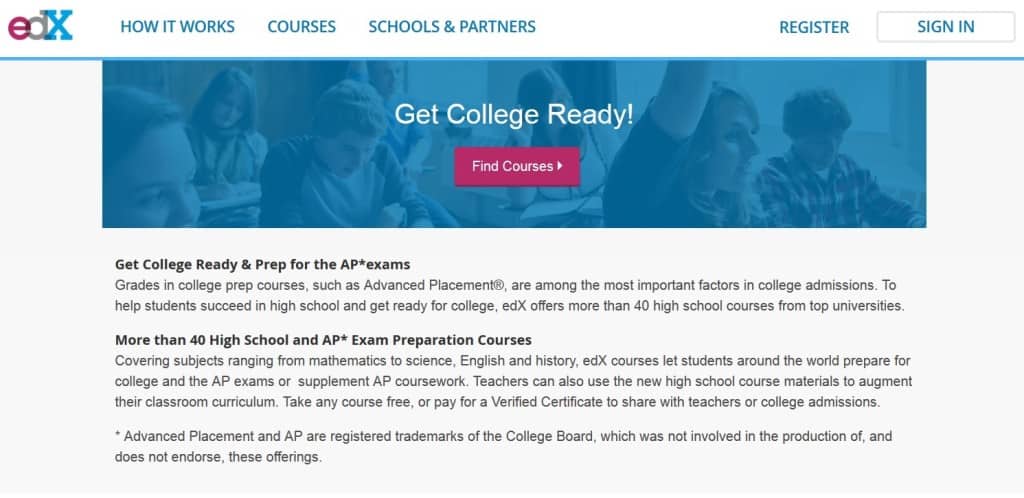Five Reasons High School Students Should Consider MOOCs
MOOCs are usually taken by college students or adults, but the are compelling reasons they may make sense for high school students.
There has been some discussion on the potential value of MOOCs for high school students, but there has been little effort focusing on this until recently. Last September, edX announced its high school initiative, fostering the development of courses, and listing them, along with others that may be relevant to high schoolers, in its own category. Last month, Futurelearn announced a similar initiative, Futurelearn Choices. EdX recent shared some data with Class Central (also see their post on learner demographics) and put us in touch with Grace Headinger, a senior at Maggie Walker’s Governor School in Richmond, VA, to provide a first-hand perspective on some of these MOOCs.
The edX category for its high school initiative MOOCs consists of 50 courses with high relevance to high schoolers, including AP exam prep, and introductory college freshman-year courses.
More than 400,000 learners have signed up for these courses (note that they are open to anyone, and at present only a small proportion are likely high school students), with the most typical age being 18 vs. 25 for all edX learners. Why would high school students take these MOOCs? It seems that there are at least five compelling reasons.
Five Reasons High School Students Should Consider MOOCs
1. To help prepare for AP exams
There over 35 Advanced Placement (AP) exams that high-schoolers can take to gain college credit. Typically, a high-school may offer some number of AP classes to prepare students for the exam. Getting AP college credit can save a lot of money and possibly shorten time to graduation. College costs are a major concern these days, as shown by President Obama’s plan to make two years of community college free.
Headinger says “AP exams are around $90, but compared to a college class–do the math, you’re savings tons of money”. MOOCs provide the opportunity to prepare for AP exams in subjects that a high school may not even be offering.
2. To get a feel for potential schools
Supporting MOOCs also reflects on the image of the school
When students are deciding which schools to apply to or have a choice between schools they can attend, MOOCs can provide an additional sense of how professors teach and what it is like to learn there. Supporting MOOCs also reflects on the image of the school, as Headinger says:
“You can get a feel for a school based on their activity in this realm…if a higher education institution is involved in offering online classes, that is a side of themselves they should definitely present…”
3. To start exploring majors
Many students start university without knowing what major they want to choose, and an estimated 80% end up changing their major. Many students are inspired to embark upon a field of study while taking a class in an unfamiliar subject and being exposed to a passionate instructor. MOOCs can help with this, as they allow high schoolers to dabble in a few courses (and even without spending too much effort) get exposed to new subject areas. This too can help them save time and money when they reach college.
4. To get perspectives from other geographies and backgrounds
MOOCs draw learners from 150+ countries around the world
One of the hallmarks of MOOCs that reach even a modest ‘massive’ size, is that they draw learners from 100+ or even 150+ countries around the world. This simply has not been possible in the past. High schoolers have the opportunity to observe (and, if they choose, contribute to) discussion board forums. They will hear the perspectives of many professionals in directly or indirectly related fields, and from people from all walks of life.
5. Just to expand one’s horizons
These go way beyond what my school teaches
The world is moving fast and thus students need to learn how to become self-directed in establishing their own learning goals. Headinger came across two unique courses on edX that piqued her interest: Alien Worlds, and the Science of Happiness. She found these subjects fascinating and the instructors compelling, and doubted she would have encountered them otherwise: “these go way beyond what my school teaches.” Thus, signing up for (and persisting in) MOOCs helps get students used to taking their education into their own hands.
There’s only one reason we would not suggest for taking high school MOOCs at this time: to gain an edge in admissions. Despite the inspirational story of Battushig Myanganbayar, the Mongolian high school student who stood out in a MOOC and was accepted into MIT, there is no clear standpoint from admissions departments on how they view these courses.
More and more high school students are taking advantage of MOOCs to help them earn college credit, gain insight into schools, and learn more about different subjects. This trend is on the rise and should continue. If you are interested in finding MOOCs geared towards high school students, check out edX High School courses, Futurelearn Choices, or the Test Prep category on Class Central.







Edward Tanguay
A sixth reason is that you don’t have to complete MOOCs, i.e. you can participate to any degree in as many MOOCs as you like without any grade penalty or loss of tuition.
Charlie Chung
Hi Edward, thanks for the comment! That’s important to point out…there’s no downside except for the time put in to it. Also, when using the content as a ‘supplement’ people can just look for what they need.